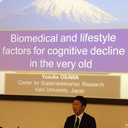Activated FGFR3 promotes bone formation via accelerating endochondral ossification in mouse model of distraction osteogenesis.
Palabras clave
Abstracto
Achondroplasia (ACH) is one of the most common short-limbed skeletal dysplasias caused by gain-of-function mutations in the fibroblast growth factor receptors 3 (FGFR3) gene. Distraction osteogenesis (DO) is a treatment option for short stature in ACH in some countries. Although the patients with ACH usually show faster healing in DO, details of the newly formed bone have not been examined. We have developed a mouse model of DO and analyzed new bone regenerates of the transgenic mice with ACH (Fgfr3ach mice) histologically and morphologically. We established two kinds of DO protocols, the short-DO consisted of 5days of latency period followed by 5days of distraction with a rate of 0.4mm per 24h, and the long-DO consisted of the same latency period followed by 7days of distraction with a rate of 0.3mm per 12h. The callus formation was evaluated radiologically by bone fill score and quantified by micro-CT scan in both protocols. The histomorphometric analysis was performed in the short-DO protocol by various stainings, including Villanueva Goldner, Safranin-O/Fast green, tartrate-resistant acid phosphatase, and type X collagen. Bone fill scores were significantly higher in Fgfr3ach mice than in wild-type mice in both protocols. The individual bone parameters, including bone volume and bone volume/tissue volume, were also significantly higher in Fgfr3ach mice than in wild-type mice in both protocols. The numbers of osteoblasts, as well as osteoclasts, around the trabecular bone were increased in Fgfr3ach mice. Cartilaginous tissues of the distraction region rapidly disappeared in Fgfr3ach mice compared to wild-type mice during the consolidation phase. Similarly, type X collagen-positive cells were markedly decreased in Fgfr3ach mice during the same period. Fgfr3ach mice exhibited accelerated bone regeneration after DO. Accelerated endochondral ossification could contribute to faster healing in Fgfr3ach mice.



